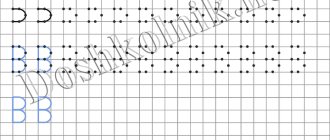Articulation
The key to good pronunciation is the correct articulation of the sounds sh and zh. To teach a child to pronounce the letters sh and z correctly, it is necessary to study one method of articulation, since the speech apparatus works almost identically when pronouncing both letters. So, in order to correctly pronounce the letter w, it is necessary to work with the articulatory apparatus as follows:
- the baby's lips should be slightly pushed forward in the shape of a tube;
- the tip of the tongue is raised to the palate so that a small gap remains between them;
- the lateral edges of the child’s tongue are pressed against the upper outer teeth, giving the tongue the shape of a cup;
- a stream of air easily passes through the unused vocal cords, creating the necessary sound.
In order to understand how to teach a child to say the letter z, it is necessary to resort to the articulation described above, while connecting the vibrations of the vocal cords. Regular exercises for making sounds are very important. These exercises can be done with a speech therapist or at home.
When to see a speech therapist
Distortion and replacement of sounds in three-year-old children is not considered a deviation. But if at 2 years old the child has no speech, then it is worth going to a consultation with a specialist. Only by the age of 5 does the formation of the phonetic series end. The setting of "Sh" occurs between the third and fifth years of life.
Violation of the pronunciation of “Ш” is correctable and is often eliminated relatively easily. The main thing is that classes are regular and systematic. It is important that the little student himself has the desire to correct his speech and pronounce “Sh” correctly.
The child and parents must show patience and perseverance during lessons. If the results are poor, then you should contact a speech therapist. A specialist can place “Ш” from the reference sound with mechanical assistance, using a probe or spatula.
Pronunciation check
Parents can check the correct pronunciation of sounds by their child themselves. There are different tests for this. You can use the same technique with which speech therapists evaluate a child’s speech at the first appointment: ask to pronounce words or syllables containing hissing sounds (for example, noise, school, came, bumblebee).
To pronounce W correctly, the tongue should be like a ladle, located in the center of the oral cavity, and not stick out forward. It is important that the tip points upward.
The verification should be carried out in stages:
- The first stage is a general check. You need to ask the child to say a couple of easy sentences that contain words with a letter (for example, “you should wear a scarf in winter,” “the cat caught the mouse”). Next, you need to move on to the pronunciation of individual words (edge, hat, good, porridge);
- the second stage is checking the sound of Ш in isolation. Attention is paid to syllables. You need to ask the baby to say “OSH”, “SHA”, “OSHO”, “USHU”. This will allow you to find out how well the child can pronounce sounds. It happens that such a check reveals problems with vowel sounds. Therefore, it is recommended to vary the syllables;
- the third stage is testing in individual syllables with voiceless and voiced consonants.
To check the pronunciation of different sounds, there are special cards with bright pictures. They are sold in children's stores. Thanks to such cards, the test can be carried out in the form of an enjoyable game.
Articulation gymnastics and its features
Before each lesson, it is necessary to sit the child down, making sure that he sits upright. All distracting objects are removed, the TV is turned off. An excellent option would be to practice in front of a mirror so that the child can see not only the articulation of the adult sitting in front of him, but also his own.
Articulation exercise in front of a mirror
- A strict sequence of exercises and regularity are the main principles that ensure the effectiveness of exercises for the speech organs. It is best to use ready-made sets of exercises that teach you to pronounce certain sounds. They are selected taking into account the age and other characteristics of the child.
- In order for the child to participate more willingly in the lesson, it is best to teach him to speak in a playful way, supplementing him with interesting riddles for the desired letter, songs, nursery rhymes and jokes
- Do not overload your child with exercises. It is better to do no more than 2-3 in one lesson, but with multiple repetitions - this makes it easier to teach the child new things.
- New exercises starting with the letter “c” can be introduced only after the child has already thoroughly mastered all the previous ones and copes with them without much effort.
- In order for the child to have the opportunity to see and correctly understand the technique of the exercises proposed to him and pronounce sounds, it is best to use a mirror for practice.
- When performing exercises, it is important to monitor the symmetry of the child’s face, the accuracy and smoothness of movements, and the correct pace. Without this, the effectiveness of the exercises will be minimized.
Video on the topic
How to teach a child to pronounce the sound Ш at home:
Thus, some children have difficulty pronouncing hissing sounds, in particular Sh. This may be due to the incorrect structure of the articulation organs and weakness of the tongue muscles.
In order to teach a child to pronounce words with the letters Ш, it is necessary to perform special exercises with him every day. You can become familiar with the features and techniques of conducting classes by watching a training video on the Internet.
Teaching your child to pronounce correctly
Parents whose children pronounce hissing sounds incorrectly are interested in how to teach their child to pronounce the letter Ш at home.
Speech therapists have developed exercises that help cope with this problem. The lesson consists of two stages: warm-up and sound production. In order for articulatory gymnastics to give a quick positive result, you need to perform it daily for 5-10 minutes.
It is necessary to show diligence and perseverance, praise the baby for success, and encourage him to do exercises.
Warm-up
Before you start performing the main complex, you need to warm up. This is necessary to prepare the oral cavity for the production of the sound Ш.
Warm-up consists of a number of simple exercises:
- place your tongue on your lower lip. Hold this position for 15 seconds;
- make a cup out of your tongue. Stay in this position for 10 counts. Relax. Make a cup out of your tongue again. This exercise trains muscle tissue well;
- click your tongue. This should be done slowly, stretching out the process;
- form a cup with your tongue, gently lower and lift it. This movement must be performed slowly and smoothly;
- alternately pronounce the sounds O and U, gesturing as much as possible with your lips (making a large circle out of them, folding them into a tube);
- make a narrow tube out of your lips and then smile widely;
- smoothly raise the tongue to the upper lip and lower it to the lower lip;
- Close your jaw, stretch your lips forward and form a kind of rectangle with them. Stay in this position for 10-15 seconds;
- lick your upper lip. This trains the upper elevation of the tongue.
Breathing exercises can prepare a child to produce the sound Ш. She teaches the baby to form the correct air stream.
The essence of breathing exercises is to perform the following exercises:
- blow on feathers, candles, pinwheels;
- try to blow a foam ball or a piece of cotton wool into the gate created for this (you can use a cardboard box);
- spread your tongue on your lower lip. Blow on the protruding tip so that the air stream passes through the center;
- Place a cotton ball on the tip of your nose. Push your lower lip forward and blow upward. You need to remove the cotton wool from your nose without using your hands, using the air flow.
It is recommended to perform all exercises in front of a mirror. During training, you can play children's songs and tell interesting stories.
Sound production
After completing breathing and articulation exercises, you can begin producing hissing sounds. There are various exercises that orient the child to the correct pronunciation of words with the letter Sh.
An effective complex for combating speech disorders:
- free flight . Make a cup out of your tongue and try to stick it out of your mouth. You need to put a small piece of cotton wool on your nose. As you exhale, the air will be pushed away from the wall of the tongue cup and rise upward, removing the cotton wool. This exercise is very simple and effective. It is especially recommended for children with a lisp;
- moving cup. Use your tongue to form a cup and begin to move it: raise and lower the edges;
- pie _ Open your mouth and place your tongue on your lower lip. Raise the side walls of the tongue so that a depression is formed along the central axis. Hold for 5-10 seconds. The exercise is aimed at strengthening the muscles of the tongue, making its lateral walls more mobile;
- ship at sea . Fold your tongue into a cup shape, lift it and hold it for 1-3 seconds, then lower it and fix it in this position for a short time;
- smile . Open your mouth and smile widely. Extend your tongue forward, placing the tip on your lower lip and the sides touching the corners of your mouth. Stay in this position for a few seconds. The exercise relaxes the tongue well. It helps in producing not only the sound Ш, but also Ж;
- swing . Open your mouth and smile. The tongue should be relaxed, flat and wide. Perform the following movements with your tongue alternately: reach to the ceiling, to the sides, to the upper and lower lips, touch the incisors, climb between the teeth and lip, touch the alveoli with the tip;
- painter _ Open your mouth slightly, smile slightly, relax your lips and fixate in this position. Imagine that the tip of your tongue is a painter’s brush, and the sky is a wall that needs to be painted. The tongue must be moved from the larynx to the teeth and back, without moving it outside the oral cavity. The exercise helps strengthen tongue control.
To pronounce complex sounds, not only production is important, but also automation. Therefore, when the child learns to pronounce Sh, you will need to move on to reinforcement exercises.







